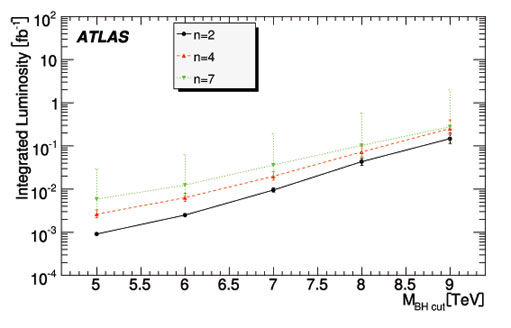
ATLAS e-News
23 February 2011
Black holes at the LHC
26 January 2009

Discovery potential for black holes for 14 TeV centre of mass energy for 2, 4 and 7 extra dimension and MPL = 1 TeV. The required luminosity is shown as a function of required reconstructed black hole mass. The error bars correspond to experimental systematic uncertainties (For more details see http://arXiv:0901.0512v1 [hep-ex]).
Black holes are fascinating objects, and I started to get interested in them as a particle physicist back in 2003 because extra dimension models predicted that they may be produced in high-energetic cosmic rays and, if so, even in particle accelerators. If we are really able to produce them, they will give us the possibility to have experimental insights to quantum gravitational effects. The study of their features may lead to a formulation of a theory of quantum gravity, a theory which would marry Einstein’s theory of general relativity, which describes gravity on large scales, with quantum mechanics, which describes physics at very small distances.
What are black holes? The simplest black holes are objects with a singularity in the centre and they possess what is called an “event horizon”. Once something comes closer to the black hole than the radius of the event horizon, it is not able to leave the black hole anymore. Even light can’t escape and hence the name black hole which was given to these objects by J. Wheeler in 1967.
How are black holes produced? If one squeezes mass into a sphere with a radius equal to the so-called Schwarzschild radius, a black hole forms. The size of the Schwarzschild radius is directly proportional to the amount of mass that is squeezed in, and it is also directly proportional to the strength of gravity.
For example, in order to form a black hole out of our Earth, one would need to squeeze its mass into a sphere of the size of a marble (RS = 8.9 mm). The Schwarzschild radius of the sun is about 3 km. If we would replace our sun by a black hole of the same mass, not much would change in our solar system. The planets orbits would stay the same because the gravitational field that the black hole would produce would be exactly the same as that of the sun. But yes, admittedly, the solar system would be bit dark and cold…
The Schwarzschild radius of two colliding partons at the LHC is RS ≤ 10-50m, which is at least fifteen orders of magnitudes below the Planck length, namely, the smallest distance or size an object can achieve. This means there is no way a black hole could be produced in a collision of two partons. But as I have mentioned in the beginning, there are models of extra spatial dimensions on the market suggesting that the strength of gravity could become significantly larger at very small distances, up to 1038 times stronger. This means the Schwarzschild radius of two colliding partons becomes large enough that at the LHC centre-of-mass energy, two partons passing each other at their Schwarzschild radius is not so unlikely anymore. Hence, we may be able to produce microscopic black holes.
What happens once you produce black holes? According to Stephen Hawking, they will not be that black in fact. They will evaporate with time approximately following a black body radiation spectrum. The evaporation rate will be inversely proportional to the black hole mass. Astronomical black holes are so massive that their evaporation rate is negligible. But microscopic black holes, because their mass is very small, will evaporate instantaneously (their expected lifetimes is of the order of ~ 10-28 – 10-25sec) into many particles which we will be able to detect in our detector. They will have very striking features. The total energy deposited in the detector will be of the order of a few TeVs and the number of final state particles will be large (10 – 40). The figure below shows the simulated ATLAS detector response to a black hole (left) and to a Higgs boson event (right). It illustrates nicely the large number of final state particles in a black hole event in comparison to other expected new processes. Black hole signatures can hardly be imitated by any other new physics so if they are being produced, it will be hard to miss them.

The left plot shows a simulated black hole event in the ATLAS detector. The right plot shows a simulated production of a Higgs event in ATLAS.
As shown in an extensive safety study undertaken last year at CERN, these black holes will evaporate so quickly that their production will be absolutely safe and present no conceivable danger.
If you would like to read more on this topic, a good starting point is “What Black Holes Can Teach Us” by Sabine Hossenfelder. The ATLAS TeV-scale Gravity Exotics subgroup is studying microscopic black holes experimental signatures and has concluded that the ATLAS detector is capable of discovering their production up to the LHC kinematic limit based on our current understanding of the signal and backgrounds as shown in the top figure. So according to these predictions, black holes should be visible within about a year of operation at nominal luminosity and 14 TeV LHC centre of mass energy.

Cigdem IsseverUniversity of Oxford
|